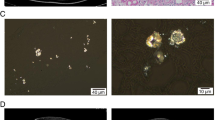Abstract
Primary hyperoxaluria (PH1) is a rare inborn autosomal recessive metabolic disorder due to the deficiency of hepatic alanine-glyoxylate-aminotransferase. This deficiency results in excessive synthesis and urinary excretion of oxalate, inducing renal stone formation and deposition of calcium oxalate in the kidney, bone, myocardium, and vessels (systemic oxalosis, SO) in the most severely affected individuals. We report renal and skeletal changes in a 3-month-old girl with PH1 and SO. Intense cortico-medullary hyperechogenicity and increased homogeneous radiopacity of normal-sized kidneys suggested the diagnosis of SO. Skeletal survey showed osteopenia and characteristic symmetrical metaphyseal transverse bands in long bones, progressively becoming more dense and migrating towards the diaphysis. Multiple pathological and slowly healing fractures of the limbs occurred at the dense band level. A radiopaque rim was then observed in flat bones, epiphyseal nuclei, and vertebral bodies. Inflammatory granulomatous reaction, induced by the presence of oxalate crystals in the marrow spaces, coexisted with progressively evident radiological signs of secondary hyperparathyroidism, with partially overlapping features. The patient was treated by peritoneal dialysis and hemodialysis until combined liver–kidney transplantation. There are no previous reports of infants treated with hemodialysis for more than 2 years.





Similar content being viewed by others
References
Cochat P, Liutkus A, Fargue S, Basmaison O, Ranchin B, Rolland MO. Primary hyperoxaluria type 1: still challenging!. Pediatr Nephrol 2006; 21: 1075–1081.
Cochat P, Collard LBDE. Primary hyperoxaluria. In: Avner ED, Harmon WE, Niaudet P, eds. Pediatric Nephrology, 5th ed. Philadelphia: Lippincott Williams & Wilkins; 2003: 807–816.
Wiggelinkhuizen J, Fisher RM. Oxalosis of bone. Pediatr Radiol 1982; 12: 307–309.
Diallo O, Janssens F, Hall M, Avni EF. Type 1 primary hyperoxaluria in pediatric patients: renal sonographic patterns. AJR 2004; 183: 1767–1770.
Fisher D, Hiller N, Drukker A. Oxalosis of bone: report of four cases and new radiological staging. Pediatr Radiol 1995; 25: 293–295.
De Zegher FE, Wolff ED, Heijden AJ, Sukhai RN. Oxalosis in infancy. Clin Nephrol 1984; 22: 114–120.
Day DL, Scheinman JI, Mahan J. Radiological aspects of primary hyperoxaluria. AJR 1986; 146: 395–401.
Ring E, Wendler H, Ratschek M, Zobel G. Bone disease of primary hyperoxaluria in infancy. Pediatr Radiol 1989; 20: 131–133.
Kamoun A, Hammou A, Chauachi S, Bellagha I, Lakhoua R. Radiological signs of type 1 primary hyperoxaluria. Ann Radiol (Paris) 1995; 38: 440–446.
Desmond P, Hennessy O. Skeletal abnormalities in primary oxalosis. Australas Radiol 1993; 37: 83–85.
Canepa G, Maroteaux P, Pietrogrande V. Sindromi dismorfiche e malattie costituzionali dello scheletro. Padova: Piccin Nuova Libraria; 1996.
Schnitzler CM, Kok JA, Jacobs DWC, et al. Skeletal manifestations of primary oxalosis. Pediatr Nephrol 1991; 5: 193–199.
Kalifa G, Dossans B, Gagnadoux MF, Sauvegrain J. Aspects radiologique de l’oxalose. J Radiol 1979; 60: 45–49.
Benhamou CL, Bardin T, Tourlière D, et al. Bone involvement in primary oxalosis. Study of 20 cases. Rev Rhum Osteoartic 1991; 58: 763–769.
Cochat P, Koch-Nogueira PC, Mahmoud MA, Jamieson NV, Scheinman JI, Rolland MO. Primary hyperoxaluria in infants: medical, ethical, and economic issues. J Pediatr 1999; 135: 746–750.
Yamauchi T, Quillard M, Takahashi S, Nguyen-Khoa M. Oxalate removal by daily dialysis in a patient with primary hyperoxaluria type 1. Nephrol Dial Transplant 2001; 16: 2407–2411.
Jamieson NV. A 20-year experience of combined liver/kidney transplantation for primary hyperoxaluria (PH1): the European PH1 transplant registry experience 1984–2004. Am J Nephrol 2005; 25: 282–289.
Author information
Authors and Affiliations
Corresponding author
Rights and permissions
About this article
Cite this article
Orazi, C., Picca, S., Schingo, P.M.S. et al. Oxalosis in primary hyperoxaluria in infancy. Skeletal Radiol 38, 387–391 (2009). https://doi.org/10.1007/s00256-008-0625-2
Received:
Accepted:
Published:
Issue Date:
DOI: https://doi.org/10.1007/s00256-008-0625-2




